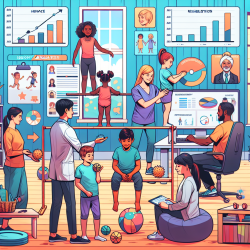Introduction
The Youth Risk Behavior Surveillance System (YRBSS) is a critical tool for understanding the health-related behaviors of high school students across the United States. Conducted by the Centers for Disease Control and Prevention (CDC), this system collects data that can be instrumental in shaping interventions and policies aimed at improving youth health outcomes. For practitioners in speech language pathology, particularly those involved in online therapy services like TinyEYE, the insights from YRBSS can be pivotal in tailoring interventions that are responsive to the evolving needs of diverse youth populations.
Understanding the YRBSS Data
The 2021 YRBSS data collection was particularly significant as it was conducted during the COVID-19 pandemic, a period marked by significant shifts in youth demographics and health behaviors. The survey captured data on a range of topics, including mental health, substance use, and experiences of violence, with a focus on the increasing diversity among high school students. Approximately half of the respondents identified as belonging to racial and ethnic minority groups, and a significant portion identified as LGBQ+ (lesbian, gay, bisexual, questioning, or other).
Implications for Speech Language Pathologists
For speech language pathologists, the YRBSS data offers valuable insights into the broader context of students' lives, which can inform more holistic and effective therapy approaches. Here are several ways practitioners can leverage this data:
- Addressing Mental Health: The data indicates a high prevalence of mental health challenges among youth, with 37% reporting poor mental health during the pandemic. Understanding these challenges can help practitioners incorporate mental health considerations into therapy sessions, ensuring that communication strategies are sensitive to the emotional states of students.
- Cultural Competency: With the increasing diversity in student populations, speech language pathologists must develop culturally competent practices. The YRBSS data highlights the need for interventions that are sensitive to the cultural and linguistic backgrounds of students, which can enhance engagement and outcomes.
- Tailoring Interventions for LGBQ+ Youth: The data reveals that LGBQ+ students face unique challenges, including higher rates of poor mental health. Practitioners should consider these factors when designing interventions, ensuring that therapy is inclusive and supportive of diverse sexual identities.
Encouraging Further Research
While the YRBSS provides a wealth of information, it also highlights areas where further research is needed. Practitioners are encouraged to delve deeper into specific issues such as the impact of community violence on communication development or the role of parental monitoring in supporting language acquisition. By contributing to the body of research, speech language pathologists can help develop evidence-based practices that are responsive to the needs of today's youth.
Conclusion
The YRBSS data is a powerful resource for speech language pathologists committed to improving child outcomes. By integrating these insights into practice, practitioners can ensure that their interventions are data-driven, culturally competent, and aligned with the current realities faced by students. As the landscape of youth demographics continues to evolve, staying informed and adaptable will be key to achieving positive outcomes in speech language pathology.
To read the original research paper, please follow this link: Overview and Methods for the Youth Risk Behavior Surveillance System — United States, 2021.










